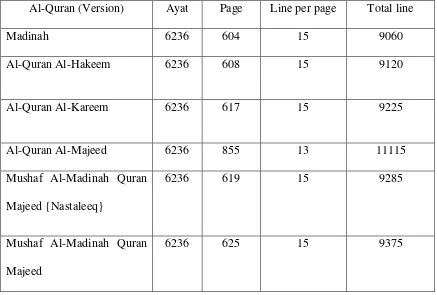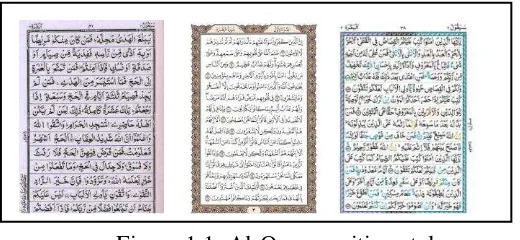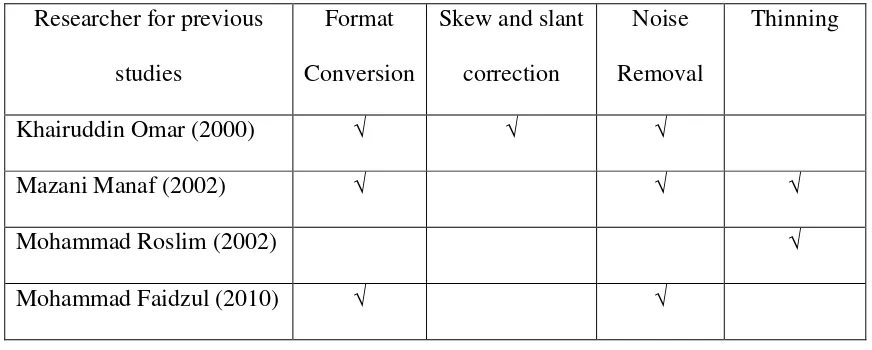Faculty of Information and Communication Technology
ILLUMINATION REMOVAL AND TEXT SEGMENTATION FOR
AL-QURAN USING BINARY REPRESENTATION
Laith Nazeeh Jamil Bany Melhem
Master of Computer Science (Internetworking Technology)
ILLUMINATION REMOVAL AND TEXT SEGMENTATION FOR AL-QURAN USING BINARY REPRESENTATION
LAITH NAZEEH JAMIL BANY MELHEM
A thesis submitted
in fulfilment of the requirements for the degree of Master of Computer Science (Internetworking Technology)
Faculty of Information and Communication Technology
UNIVERSITI TEKNIKAL MALAYSIA MELAKA
DECLARATION
I declare that this project entitled “Illumination Removal and Text Segmentation for Al-Quran Using Binary Representation” is the result of my own research except as cited in the
references. The project has not been accepted for any degree and is not concurrently submitted in candidature of any other degree.
APPROVAL
I hereby declare that I have read this project and in my opinion this project is sufficient in terms of scope and quality for the award of Master of Computer Science (Internetworking Technology).
DEDICATION
i ABSTRACT
ii ABSTRAK
iii
ACKNOWLEDGEMENT
First and foremost, praise to Allah, for giving me this opportunity, the strength and the patience to complete my project finally, after all the challenges and difficulties. I would like to take this opportunity to express my sincere acknowledgement to my supervisor Dr. Mohd Sanusi Bin Azmi from the Faculty of Information & Communication Technology Universiti Teknikal Malaysia Melaka (UTeM) for her essential supervision, support and encouragement towards the completion of this thesis. Thanks for king Fahd Glorious Quran Printing Complex to publish the styles of Al-Quran to use it during the research. To my beloved my family and the jewel my heart my mother. Thank you for the sacrifices, patience, support and compassion which has become one enters my life. Not to forget also to all my colleagues and friends struggling for Master's that inspire a vision, guidance and sharing experiences.
iv
2.2.1 Progress in Binarization Studies ... 8
2.2.2 Border/Illumination Removal ... 14
2.3 Arabic OCR ... 16
2.4 Image Segmentation ... 18
2.5 Techniques for Document of Text Segmentation ... 19
v
Appendix A Questionnaire ... 79
vi
LIST OF TABLES
TABLE TITLE PAGE
Table 1.1: Summary of Ayat, Page and Line from printed Al-Quran 2 Table 2.1: Image processing steps for Jawi pattern recognition (Azmi, 2013) 9
Table 2.2: Categorization of segmentation algorithms (Nikos et al., 2010) 18
Table 2.3: Text line segmentation methods analysis 26
vii
LIST OF FIGURES
FIGURE TITLE PAGE
Figure 1.1: Al-Quran writing styles 4
Figure 2.1: Example of an image with noisy black border and noisy text region 14
Figure 2.2: General Arabic OCR systems capabilities 16
Figure 3.1: Research Framework 36
Figure 3.2: Al-Quran writing styles 37
Figure 3.3: The Illumination Removal in Al-Quran and segmentation to Pages and Lines
Framework 39
Figure 3.4: Page (10) from Holy Al-Quran 40
Figure 4.1: Al-Quran writing styles 43
Figure 4.2: The Illumination Removal in Al-Quran and segmentation to Pages and Lines
Framework 44
Figure 4.3: Overall steps for removing page frames 45
Figure 4.4: Flowchart for blank space and Illumination detection and removal 47 Figure 4.5: The process for removing the exterior blank space and marginal Illumination
from Al-Quran page 48
Figure 4.6: The process for removing the Illumination from Al-Quran page 50 Figure 4.7: The process for removing the interior blank space from Al-Quran page 52
Figure 4.8: Flowchart for text line segmentation 54
viii
Figure 5.1: Pie Chart for the Gender 58
Figure 5.2: Pie Chart for the Race 59
Figure 5.3: Pie Chart for the Country 59
Figure 5.4: Pie Chart for the Student Category 60
Figure 5.5: Pie Chart for the Faculty 60
Figure 5.6: Column Chart for Segmentation 61
Figure 5.7: Pie Chart for Page Segmentation 61
Figure 5.8: Pie Chart for Text Line Segmentation 62
Figure 5.9: User Interface for Selection File(s) 63
Figure 5.10: User Interface for Binarization 63
Figure 5.11: User Interface for Save Pages and Line 63
Figure 5.12: The Output Files 64
Figure 5.13: Result of Page Segmenttion 64
1 CHAPTER 1
INTRODUCTION
1.1 Introduction
Image processing is a popular research area in computer science. Today, image processing not only focuses on fundamental issues addressed by researches also the suitability of the research into several domains such as biometric (Phillips et al., 1998), geographical information system (Câmara et al., 1996), character recognition (Omar, 2000), document analysis (Sauvola and Pietikäinen, 2000) and others.
Image Processing is a technique to enhance raw images received from cameras/sensors placed on satellites, space probes and aircrafts or pictures taken in normal day-to-day life for various applications (Rao, 2004). There are three main categories of image processing: Image Enhancement, Image Rectification, and Restoration, and Image Classification.
Various techniques have been developed in Image Processing during the last four to five decades. Most of the techniques are developed for enhancing images obtained from unmanned spacecrafts, space probes and military reconnaissance flights. Image Processing systems are becoming popular due to easy availability of powerful personnel computers, large size memory devices, graphics software etc (Rao, 2004).
pre-2
processing, feature extraction, feature selection, classification, and post processing (Azmi, 2013; Nasrudin et al., 2010; Omar, 2000). Each phase in the image processing has sub-processes. (Omar, 2000) has category the pre-processing phase for the Arabic/Jawi character recognition into Binarization, Edge detection, thinning, and Segmentation before feature extraction took place.
In this research, focus is in segmentation for holy Quran. Thus, Segmentation for holy Quran based on processes for segmenting Arabic/Jawi handwritten texts.
Holy Quran is book of Allah swt. Al-Quran consists of 30 chapters, 114 Surah and 6036 Ayat. However, number of pages and lines are difference based on publishers. Table 1.1 below shows example of printed Al-Quran from different publishers.
Table 1.1: Summary of Ayat, Page and Line from printed Al-Quran
Al-Quran (Version) Ayat Page Line per page Total line
Madinah 6236 604 15 9060
Based on Table 1.1, issues on segmentation Al-Quran is not uniform. Although the
3
difference number of page and line become interesting topic to be studied especially in the segmentation process.
Segmentation process for segmenting Al-Quran needs to be studied carefully. This is because Al-Quran is the book of Allah swt. Any incorrect segmentation will affect the holiness of Al-Quran.
Currently, exist some segmentation techniques such as Naive Bayes Classifier (Bidgoli and Boraghi, 2010), however the segmentation techniques focus on segmenting object such as text and face segmentation (Khattab et al., 2014). Also, there are some segmentation techniques for Arabic and Jawi character (Omar, 2000). Although, Arabic and Jawi characters are quite near to Al-Quran, however the techniques in Arabic and Jawi do not have diacritical marks (Omar, 2000).
In this research, one technique for segmenting Al-Quran will be proposed. The line for each printed Al-Quran. Besides, Figure 1.1, Al-Quran is written with different style
4
The segmentation process in this research is use to prepare image for feature extraction process. In the Al-Quran, texts and Diacritical marks (Tashkil) will be extracted. Thus, the illumination and some empty space will be removed.
In this research “illumination” refers to the art of embellishing and decorating the
Holy Quran. It is used in Islamic arts. This is used in the first and last page of Al-Quran, a head of each ‘Sura’ and a border of each page in Al-Quran and other places (Tajabadi et
al., 2009).
Forming decorative arrays and Islamic designs in this holy Quranic art has come from consolidated ideas and worldviews of artists of this field. So that, many calligraphists and number of (not less) illuminators read Quran in a memorized manner. But those less people who were not able to read Quran in a memorized manner, were so familiar with its verses that it had become an integrated part of their nature. (Lings, 1998). Manifestation of spirituality in illumination of Quran is to the extent that it has made this art worthy of companion of the holy Quran and in fact, manifestation of the divine realm is duty of the art evoked by the word of God. And it can be said that Quran itself has opportunities that stimulates religion (Lings, 1998).
1.3 Problem Statement
Arabic language (Quran Language) has markings called “diacritical marks” or
“diacritics” represent short vowels or other sounds if one of these diacritical marks ignored Figure 1.1: Al-Quran writing styles
5
it will change the meaning of the word, There are many Arabic character recognition techniques which can recognize the characters of text or the whole page Khairuddin Omar(2000), Mohamad Faidzul (2010) but all these techniques provide recognition for characters without considering the diacritical marks, which may affect the meaning of the Quran’s word and the holiness of Al-Quran.
1.4 Research Questions
How the segmentation process for Al-Quran happen in image processing domain? How to segment illumination occur in Al-Quran with different form of illumination
and without missing any diacritic?
1.5 Research Objectives
This study has certain objectives as follows:
• To propose framework for Segmenting Al-Quran into page and line • To propose a technique to segmenting texts of Al-Quran
1.6 Project Significant
6
1.7 The Scope of Research
The scope of research is:
i. This research study will primarily focus on removing the border of the Quran pages by cropping the page of Quran first, then crop line by line of the page without the empty space
ii. This technique will be applied on all the Quran pages except the first and second pages which are “Surat Fatihah and the first page of Surat
Al-Baqarah” in the Quran that its writing styles comes with a circle border for
these two pages.
1.8 Expected Outcomes
The main expected outcomes for this research to design application that provide a technique that produced better image for Holy Quran page image without the border, then cropping the image page line-by-line after line segmentation.
1.9 Conclusion
7 CHAPTER 2
LITERATURE REVIEW
2.1 Introduction
Nowadays we are living in a world that is almost entirely digital. So, many digital documents are available. Research on document originality are exist (Qadir and Ahmad, 2006). For this research, study will be done on Al-Quran. There are too many printed versions of Quran as well as digital copy. This research will do the segmentation on Al-Quran for the removing illumination and segmenting Al-Al-Quran by lines. This research will prepare the Al-Quran for feature extraction phase and the final aim is to validate the originality of Al-Quran.
There are too many research on segmentation, however, segmenting the Al-Quran need to do carefully in order to preserve the holiness of Al-Quran. Research that nearly to Quran are Arabic/Jawi segmentation. But, both are not suitable to be applied for Al-Quran due to diacritics diacritical marks (Tashkil), words, and sentences.
The first step before segmentation phase is preprocessing documents to produce a clean image of the document. Al-Quran page image contained Illumination. Detecting and removing these unwanted areas is critical to achieve better text segmentation results. Before the illumination detection and removal takes place, we first proceed to image binarization using the efficient technique proposed in (Gatos et al., 2006).
8
recognition into Binarization, Edge detection, thinning, and Segmentation before feature extraction took place.
We are trying in our research to understand the image processing and text segmentation. Images used in our study will be are an image of Al-Quran pages. At this point, Will be explained the previous studies on text line segmentation in detail. The main objective of this research is to seek out the better method to segment Al-Quran pages without missing any character or diacritical marks.
2.2 Image Pre-processing
2.2.1 Progress in Binarization Studies
A binary image (Stathis et al., 2008) is a digital image that has just two feasible values meant for every pixel. Normally, two colors are used for a binary image i.e. black and white however any two colors can be used. The color used for the objects in the image is the foreground color while the rest of the image is the background color. Binary images (Su et al., 2011) frequently occur in image processing as masks or as the outcome of some operations as segmentation and thresholding. Few input/output devices, for example, laser printers, bi-level computer displays, are able to just handle bi-level images. Binary images are formed from color images by segmentation.
Various approaches as well as techniques were developed to improve documents images quality. Binarization is one of the most important pre-processing steps which consist to separate foreground and background of documents images. It converts a gray-scale document image into a binary document image.
9
Mohd Sanusi (2013) shows the processes within the pre-processing carried out by researchers within the Jawi script. This process is predicated on the process performed by Khairuddin Omar (2000). Overall stages that were utilized by the pioneers of Jawi script Khairuddin Omar (2000) has committed method of images reborn to a scale illustration of color, skew and slant correction, noise removal, and thinning of the frame (skeleton). However, the process utilized by Khairuddin Omar (2000) not all of them are utilized by researchers to conduct pre-processing as shown in Table 2.1.
10
using sequential thinning algorithm Safe-Point Thinning Algorithm (SPTA) proposed by Naccache, & Shinghal (1984). SPTA algorithm is also used by Roslim Mohammad (2002) in the thinning of the Jawi script.
Mazani Manaf (2002) in pre-processing employs "gamma correction and intensity". Next the uses of a linear function with the planned technique desires by Parker (1994) to convert the image to grayscale format. The noise removal method, then being executed by using erosion operation followed by reclamation as proposed by Zhang, & Suen (1984). After that, to de-noise employs the median filter. Finally, Mazani Manaf (2002) using a simple sequential thinning algorithm performs a thinning process framework based on Zhang and Suen (1984).
Mohammad Faidzul (2010) in his study has taken knowledge from nine writers. The primary method done by him is doing segmentation that performed manually. however he did't doing the noise removal in his research. The results of this manually segmentation, he obtained 993 total characters and 540 sub-word from nine last author. Next, format conversion method to be enforced using the binary scale thresholds of 127. Mohammad Faidzul (2010) did't perform the repair method skew and slant and additionally the thinning skeleton.
11
Hossein Ziaei Nafchi et al.(2013) (Nafchi et al., 2013) has concluded that the pre-processing and post pre-processing phases meaningfully advance the performance of binarization approaches, particularly in the situation of harshly degraded ancient documents. An unverified post processing technique is presented founded on the phase-preserved denoised image and also phase congruency features extracted from the input image. The central part of the technique comprises of two robust mask images that can be used to cross the false positive pixels on the production of the binarization technique. Firstly, a mask with an extreme recall value is attained from the denoised image with the help of morphological procedures. In parallel, a second cover is acquired dependent upon stage congruency features. At that point, a median filter is utilized to evacuate noise on these two masks, which then are utilized to rectify the yield of any binarization strategy.
Jon Parker et al.(2013) (Parker et al., 2013) has studied that regularly documents of notable noteworthiness are ran across in a state of deterioration. Such archives are regularly examined to all the while history and announce a disclosure. Changing over the data found inside such reports to open information happens all the more rapidly and inexpensively if a programmed technique to upgrade these corrupted archives is utilized as opposed to improving each one document image by hand. A novel mechanized image upgrade approach that indulges no preparation information was introduced. The methodology was valid to images of typewritten text in addition to hand written text or both.


